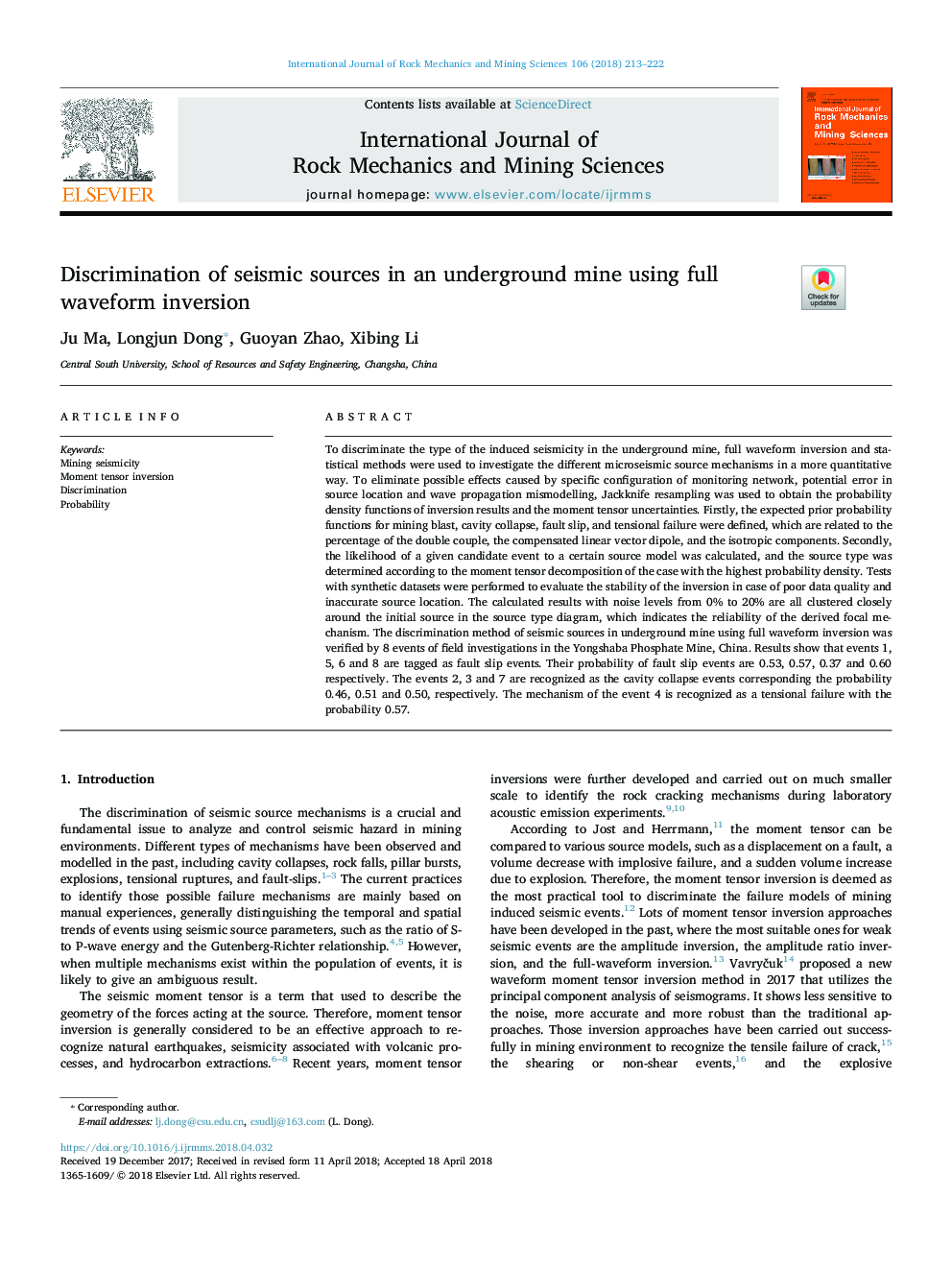| کد مقاله | کد نشریه | سال انتشار | مقاله انگلیسی | نسخه تمام متن |
|---|---|---|---|---|
| 7206202 | 1468663 | 2018 | 10 صفحه PDF | دانلود رایگان |
عنوان انگلیسی مقاله ISI
Discrimination of seismic sources in an underground mine using full waveform inversion
ترجمه فارسی عنوان
تبیین منابع لرزه ای در معدن زیرزمینی با استفاده از تبدیل شکل موج کامل
دانلود مقاله + سفارش ترجمه
دانلود مقاله ISI انگلیسی
رایگان برای ایرانیان
کلمات کلیدی
لرزه خیزی معدن، معکوس تانسور لحظه، تبعیض احتمال
ترجمه چکیده
برای تشخیص نوع لرزه خیزی ناشی از معادن زیرزمینی، روشهای پیچیده موج و روشهای آماری برای بررسی مکانیزمهای مختلف میکروزیلیسمی به روش کمی بیشتر مورد استفاده قرار گرفت. برای از بین بردن اثرات احتمالی ناشی از پیکربندی خاص شبکه نظارت، خطای بالقوه در موقعیت منبع و مدل غلط امواج انتشار موج، برای به دست آوردن توابع چگالی احتمالی نتایج معکوس و عدم قطعیت های تانسور لحظه ای، بازنگری جک نایف مورد استفاده قرار گرفت. در مرحله اول، توابع احتمالی احتمالی پیش بینی شده برای انفجار معدن، حفره حفره، لغزش گسل و شکست تنشی تعریف شد که مربوط به درصد زوج دوگانه، دو قطبی بردار خطی جبران شده و اجزای ایزوتروپیک است. ثانیا احتمال یک رویداد کاندید داده شده به یک مدل منبع خاص محاسبه شد و نوع منبع براساس تجمع تانسور لحظه مورد با بیشترین چگالی احتمال تعیین شد. تست های با مجموعه داده های مصنوعی برای ارزیابی پایداری معکوس در مورد کیفیت ضعیف داده ها و محل نادرست منبع انجام شد. نتایج محاسبه شده با سطوح سر و صدا از 0 تا 20 درصد همه نزدیک به منبع اولیه در نمودار نوع منبع خوشه بندی شده اند که نشان دهنده قابلیت اطمینان مکانیزم کانونی مشتق شده است. روش تبعیض منابع لرزه ای در معادن زیرزمینی با استفاده از شکل موج کامل به وسیله 8 رویداد تحقیقات میدانی در معدن فسفات یونشبا، چین تایید شد. نتایج نشان می دهد که رویدادهای 1، 5، 6 و 8 به عنوان رویدادهای لغزش گسل برچسب گذاری می شوند. احتمال وقوع لغزش گسل ها به ترتیب 0.53، 0.57، 0.37 و 0.60 می باشد. وقایع 2، 3 و 7 به عنوان رویدادهای فروپاشی حفره مطابق با احتمال 0.46، 0.51 و 0.50 به رسمیت شناخته شده است. مکانیزم رویداد 4 به عنوان یک شکست تنشی با احتمال 0.57 به رسمیت شناخته شده است.
موضوعات مرتبط
مهندسی و علوم پایه
علوم زمین و سیارات
مهندسی ژئوتکنیک و زمین شناسی مهندسی
چکیده انگلیسی
To discriminate the type of the induced seismicity in the underground mine, full waveform inversion and statistical methods were used to investigate the different microseismic source mechanisms in a more quantitative way. To eliminate possible effects caused by specific configuration of monitoring network, potential error in source location and wave propagation mismodelling, Jackknife resampling was used to obtain the probability density functions of inversion results and the moment tensor uncertainties. Firstly, the expected prior probability functions for mining blast, cavity collapse, fault slip, and tensional failure were defined, which are related to the percentage of the double couple, the compensated linear vector dipole, and the isotropic components. Secondly, the likelihood of a given candidate event to a certain source model was calculated, and the source type was determined according to the moment tensor decomposition of the case with the highest probability density. Tests with synthetic datasets were performed to evaluate the stability of the inversion in case of poor data quality and inaccurate source location. The calculated results with noise levels from 0% to 20% are all clustered closely around the initial source in the source type diagram, which indicates the reliability of the derived focal mechanism. The discrimination method of seismic sources in underground mine using full waveform inversion was verified by 8 events of field investigations in the Yongshaba Phosphate Mine, China. Results show that events 1, 5, 6 and 8 are tagged as fault slip events. Their probability of fault slip events are 0.53, 0.57, 0.37 and 0.60 respectively. The events 2, 3 and 7 are recognized as the cavity collapse events corresponding the probability 0.46, 0.51 and 0.50, respectively. The mechanism of the event 4 is recognized as a tensional failure with the probability 0.57.
ناشر
Database: Elsevier - ScienceDirect (ساینس دایرکت)
Journal: International Journal of Rock Mechanics and Mining Sciences - Volume 106, June 2018, Pages 213-222
Journal: International Journal of Rock Mechanics and Mining Sciences - Volume 106, June 2018, Pages 213-222
نویسندگان
Ju Ma, Longjun Dong, Guoyan Zhao, Xibing Li,
